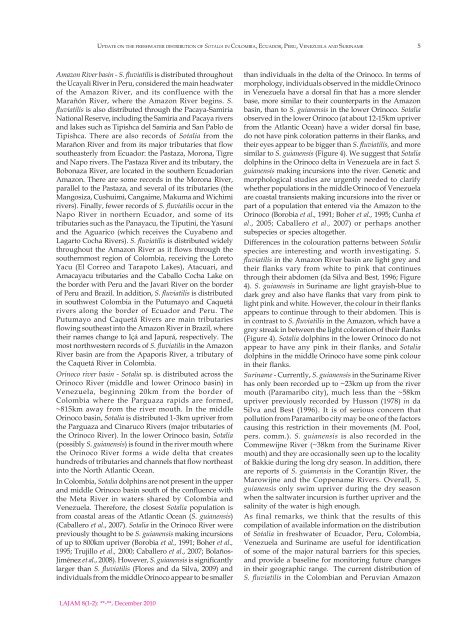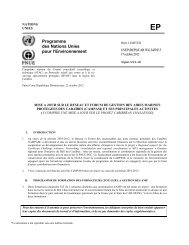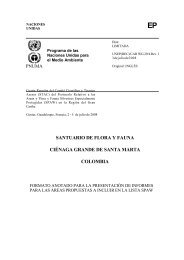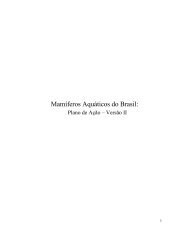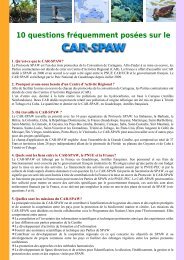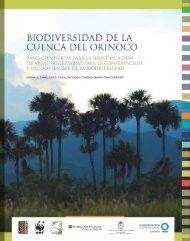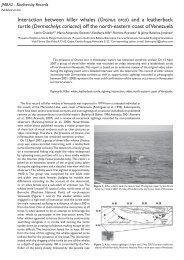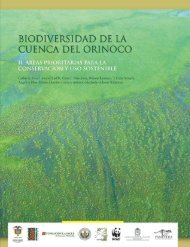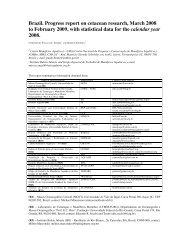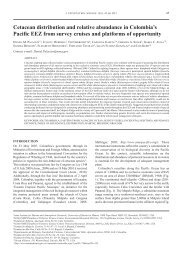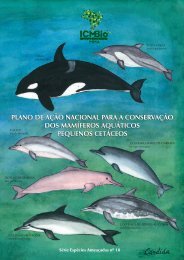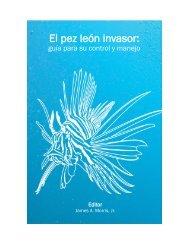18 Gomez Salazar et al.pmd
18 Gomez Salazar et al.pmd
18 Gomez Salazar et al.pmd
You also want an ePaper? Increase the reach of your titles
YUMPU automatically turns print PDFs into web optimized ePapers that Google loves.
UPDATE ON THE FRESHWATER DISTRIBUTION OF SOTALIA IN COLOMBIA, ECUADOR, PERU, VENEZUELA AND SURINAME 5Amazon River basin - S. fluviatilis is distributed throughoutthe Ucay<strong>al</strong>i River in Peru, considered the main headwaterof the Amazon River, and its confluence with theMarañón River, where the Amazon River begins. S.fluviatilis is <strong>al</strong>so distributed through the Pacaya-SamiriaNation<strong>al</strong> Reserve, including the Samiria and Pacaya riversand lakes such as Tipishca del Samiria and San Pablo deTipishca. There are <strong>al</strong>so records of Sot<strong>al</strong>ia from theMarañon River and from its major tributaries that flowsoutheasterly from Ecuador: the Pastaza, Morona, Tigreand Napo rivers. The Pastaza River and its tributary, theBobonaza River, are located in the southern EcuadorianAmazon. There are some records in the Morona River,par<strong>al</strong>lel to the Pastaza, and sever<strong>al</strong> of its tributaries (theMangosiza, Cushuimi, Cangaime, Makuma and Wichimirivers). Fin<strong>al</strong>ly, fewer records of S. fluviatilis occur in theNapo River in northern Ecuador, and some of itstributaries such as the Panayacu, the Tiputini, the Yasuníand the Aguarico (which receives the Cuyabeno andLagarto Cocha Rivers). S. fluviatilis is distributed widelythroughout the Amazon River as it flows through thesouthernmost region of Colombia, receiving the Lor<strong>et</strong>oYacu (El Correo and Tarapoto Lakes), Atacuari, andAmacayacu tributaries and the Cab<strong>al</strong>lo Cocha Lake onthe border with Peru and the Javari River on the borderof Peru and Brazil. In addition, S. fluviatilis is distributedin southwest Colombia in the Putumayo and Caqu<strong>et</strong>árivers <strong>al</strong>ong the border of Ecuador and Peru. ThePutumayo and Caqu<strong>et</strong>á Rivers are main tributariesflowing southeast into the Amazon River in Brazil, wher<strong>et</strong>heir names change to Içá and Japurá, respectively. Themost northwestern records of S. fluviatilis in the AmazonRiver basin are from the Apaporis River, a tributary ofthe Caqu<strong>et</strong>á River in Colombia.Orinoco river basin - Sot<strong>al</strong>ia sp. is distributed across theOrinoco River (middle and lower Orinoco basin) inVenezuela, beginning 20km from the border ofColombia where the Parguaza rapids are formed,~815km away from the river mouth. In the middleOrinoco basin, Sot<strong>al</strong>ia is distributed 1-3km upriver fromthe Parguaza and Cinaruco Rivers (major tributaries ofthe Orinoco River). In the lower Orinoco basin, Sot<strong>al</strong>ia(possibly S. guianensis) is found in the river mouth wher<strong>et</strong>he Orinoco River forms a wide delta that createshundreds of tributaries and channels that flow northeastinto the North Atlantic Ocean.In Colombia, Sot<strong>al</strong>ia dolphins are not present in the upperand middle Orinoco basin south of the confluence withthe M<strong>et</strong>a River in waters shared by Colombia andVenezuela. Therefore, the closest Sot<strong>al</strong>ia population isfrom coast<strong>al</strong> areas of the Atlantic Ocean (S. guianensis)(Cab<strong>al</strong>lero <strong>et</strong> <strong>al</strong>., 2007). Sot<strong>al</strong>ia in the Orinoco River werepreviously thought to be S. guianensis making incursionsof up to 800km upriver (Borobia <strong>et</strong> <strong>al</strong>., 1991; Boher <strong>et</strong> <strong>al</strong>.,1995; Trujillo <strong>et</strong> <strong>al</strong>., 2000; Cab<strong>al</strong>lero <strong>et</strong> <strong>al</strong>., 2007; Bolaños-Jiménez <strong>et</strong> <strong>al</strong>., 2008). However, S. guianensis is significantlylarger than S. fluviatilis (Flores and da Silva, 2009) andindividu<strong>al</strong>s from the middle Orinoco appear to be sm<strong>al</strong>lerthan individu<strong>al</strong>s in the delta of the Orinoco. In terms ofmorphology, individu<strong>al</strong>s observed in the middle Orinocoin Venezuela have a dors<strong>al</strong> fin that has a more slenderbase, more similar to their counterparts in the Amazonbasin, than to S. guianensis in the lower Orinoco. Sot<strong>al</strong>iaobserved in the lower Orinoco (at about 12-15km upriverfrom the Atlantic Ocean) have a wider dors<strong>al</strong> fin base,do not have pink coloration patterns in their flanks, andtheir eyes appear to be bigger than S. fluviatilis, and moresimilar to S. guianensis (Figure 4). We suggest that Sot<strong>al</strong>iadolphins in the Orinoco delta in Venezuela are in fact S.guianensis making incursions into the river. Gen<strong>et</strong>ic andmorphologic<strong>al</strong> studies are urgently needed to clarifywh<strong>et</strong>her populations in the middle Orinoco of Venezuelaare coast<strong>al</strong> transients making incursions into the river orpart of a population that entered via the Amazon to theOrinoco (Borobia <strong>et</strong> <strong>al</strong>., 1991; Boher <strong>et</strong> <strong>al</strong>., 1995; Cunha <strong>et</strong><strong>al</strong>., 2005; Cab<strong>al</strong>lero <strong>et</strong> <strong>al</strong>., 2007) or perhaps anothersubspecies or species <strong>al</strong>tog<strong>et</strong>her.Differences in the colouration patterns b<strong>et</strong>ween Sot<strong>al</strong>iaspecies are interesting and worth investigating. S.fluviatilis in the Amazon River basin are light grey andtheir flanks vary from white to pink that continuesthrough their abdomen (da Silva and Best, 1996; Figure4). S. guianensis in Suriname are light grayish-blue todark grey and <strong>al</strong>so have flanks that vary from pink tolight pink and white. However, the colour in their flanksappears to continue through to their abdomen. This isin contrast to S. fluviatilis in the Amazon, which have agrey streak in b<strong>et</strong>ween the light coloration of their flanks(Figure 4). Sot<strong>al</strong>ia dolphins in the lower Orinoco do notappear to have any pink in their flanks, and Sot<strong>al</strong>iadolphins in the middle Orinoco have some pink colourin their flanks.Suriname - Currently, S. guianensis in the Suriname Riverhas only been recorded up to ~23km up from the rivermouth (Paramaribo city), much less than the ~58kmupriver previously recorded by Husson (1978) in daSilva and Best (1996). It is of serious concern thatpollution from Paramaribo city may be one of the factorscausing this restriction in their movements (M. Pool,pers. comm.). S. guianensis is <strong>al</strong>so recorded in theCommewijne River (~38km from the Suriname Rivermouth) and they are occasion<strong>al</strong>ly seen up to the loc<strong>al</strong>ityof Bakkie during the long dry season. In addition, thereare reports of S. guianensis in the Corantijn River, theMarowijne and the Coppename Rivers. Over<strong>al</strong>l, S.guianensis only swim upriver during the dry seasonwhen the s<strong>al</strong>twater incursion is further upriver and thes<strong>al</strong>inity of the water is high enough.As fin<strong>al</strong> remarks, we think that the results of thiscompilation of available information on the distributionof Sot<strong>al</strong>ia in freshwater of Ecuador, Peru, Colombia,Venezuela and Suriname are useful for identificationof some of the major natur<strong>al</strong> barriers for this species,and provide a baseline for monitoring future changesin their geographic range. The current distribution ofS. fluviatilis in the Colombian and Peruvian AmazonLAJAM 8(1-2): **-**, December 2010


